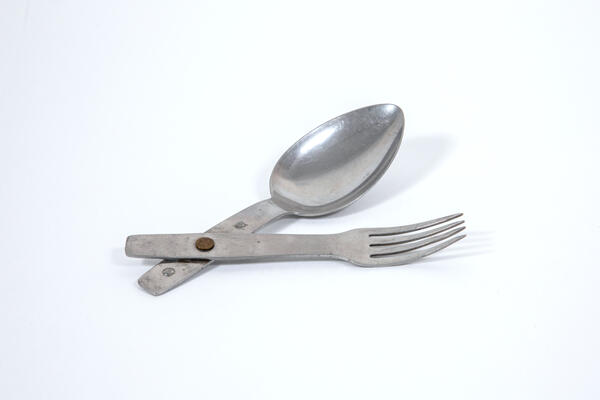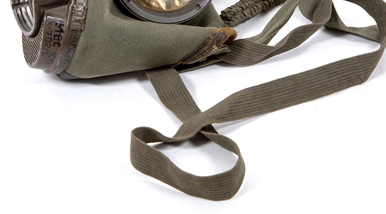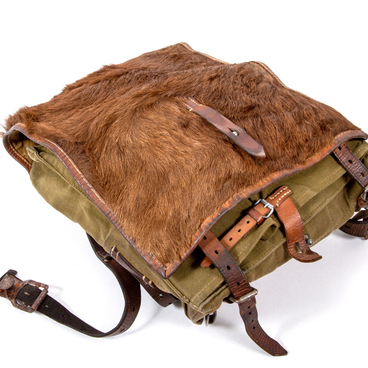The German soldier’s equipment included a compact form of cutlery — a combined spoon and fork. It was used by soldiers of the Reichswehr, the armed forces of the Weimar Republic, and by soldiers of the Wehrmacht during World War II.
This cutlery included a spoon and fork, which were fastened with a metal rivet, therefore they could be rotated and fixed in one line. The manufacturer and the year of manufacture were embossed on the handle. Sometimes the imperial eagle was depicted, as well.
The spork displayed in the museum is made of stainless metal, presumably steel. The preserved factory branding indicates “W.S.M. 41 ROSTFREI”. It means that the cutlery was produced in 1941 and made of “stainless” material. Since about 1943, the sporks began to be made of cheaper iron, rarely — of lightweight aluminum.
Almost every German soldier had a spork. In field conditions, it was kept in the inner pocket of the dry bag. Some folding cutlery sets, called Essbesteck, also included a table knife and a can opener.
Dozens of German factories produced similar items during World War II. Many firms and companies, which manufactured such items for the armed forces of Nazi Germany, continued to work after the war. Company W.S.M. — W. Seibel Metalle, Mettmann — which produced the spork, displayed in the Museum Resource Center, produces cutlery to this day.
The founder of the company, Wilhelm Seibel, was born in 1843 in Gebersdorf (modern Frielendorf). In 1895 he founded the W. Seibel, Mettmanner Britanniawarenfabrik, and in 1911 opened the “Hessische Metallwerke Gebr. Seibel, Ziegenhain” factory, which later passed into the hands of his two younger sons Heinrich and Alfred.
Seibel’s company became famous by producing cutlery for the Berlin Summer Olympics in 1936. Seibel’s products were used by the German infantry, air and naval forces. By the end of the war, it was shut down, but from May 1945, it began to recover.
This cutlery included a spoon and fork, which were fastened with a metal rivet, therefore they could be rotated and fixed in one line. The manufacturer and the year of manufacture were embossed on the handle. Sometimes the imperial eagle was depicted, as well.
The spork displayed in the museum is made of stainless metal, presumably steel. The preserved factory branding indicates “W.S.M. 41 ROSTFREI”. It means that the cutlery was produced in 1941 and made of “stainless” material. Since about 1943, the sporks began to be made of cheaper iron, rarely — of lightweight aluminum.
Almost every German soldier had a spork. In field conditions, it was kept in the inner pocket of the dry bag. Some folding cutlery sets, called Essbesteck, also included a table knife and a can opener.
Dozens of German factories produced similar items during World War II. Many firms and companies, which manufactured such items for the armed forces of Nazi Germany, continued to work after the war. Company W.S.M. — W. Seibel Metalle, Mettmann — which produced the spork, displayed in the Museum Resource Center, produces cutlery to this day.
The founder of the company, Wilhelm Seibel, was born in 1843 in Gebersdorf (modern Frielendorf). In 1895 he founded the W. Seibel, Mettmanner Britanniawarenfabrik, and in 1911 opened the “Hessische Metallwerke Gebr. Seibel, Ziegenhain” factory, which later passed into the hands of his two younger sons Heinrich and Alfred.
Seibel’s company became famous by producing cutlery for the Berlin Summer Olympics in 1936. Seibel’s products were used by the German infantry, air and naval forces. By the end of the war, it was shut down, but from May 1945, it began to recover.



